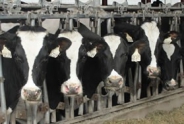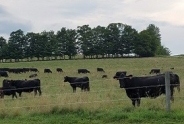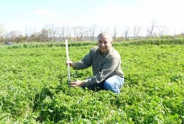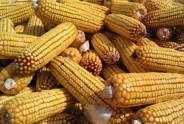Opportunity Areas Affecting Herd Profitability
David Balbian, Area Dairy Specialist
Central New York Dairy and Field Crops
April 30, 2014
The competitiveness of the dairy industry today is nothing short of amazing. Some may call it frustrating and at times it certainly can be. The volatility of the milk price is pretty much out of your hands. Not only is the price affected by our US supply demand situation, it is also impacted by the international supply demand situation and other foreign events. Grain prices are also very volatile and you cannot change this. For most dairy farms purchased grain is the single largest expense.
In the broadest of terms, dairy producers need to step back and think about a very simplistic formula as they consider changes in their operation that hopefully will improve profits. That formula is:
Dairy Profitability = (milk price - cost of production) x lbs. of milk sold. In simple terms, one or more of the three items in the formula needs to change to improve profitability.
INCREASE THE PRICE YOU RECEIVE FOR YOUR MILK
Quality Premiums—getting the maximum quality premium every month is often difficult. However, they can certainly add up and you should strive to get them. With the SCC component research tells us that there is additional milk production to be had with lower SCC levels and that is also an economic benefit.
Increased Components—work with your nutritionist on this one. We know how to positively impact them. For Holstein herds butterfat < 3.5% & and milk protein < 3.0% means there are opportunities. You need to weigh the cost vs. returns for your herd when it comes to the changes necessary to impact components.
rBST Free Premium— this is a hot potato item for some people. If you are not receiving a premium and are not using rBST simply inquire about it. For those using rBST the lack of a premium for not using it can be small or sometimes large, especially if the market for your milk becomes limited and you have to change handlers and/or pay additional hauling to have milk sent to a specific plant.
Market Premium—sometimes available when milk supplies are tight and/or coops and handlers are competing for a milk supply. Don’t be shy in asking for them.
Volume Premiums—larger herds have been able to benefit here because it costs the handler less money per cwt. to pick up large quantities vs. small quantities with multiple stops.
Organic Price—An entire change in management to consider. Price is higher, but so are costs.
COST OF PRODUCTION
Input Prices—do some shopping around. Don’t be afraid to bargain. Take advantage of cash discounts and volume discounts when you can.
Increase Production Efficiency—I know some people are sick of hearing this one. However, this is a big item that includes all the herd management items that we always talk about. It includes good reproductive performance, low mastitis incidence, an excellent heifer raising program, good cow comfort, and a top notch transition cow program.
A Well Balanced Business—by this I mean a business that has everything synchronized and well matched to the overall herd size. This includes the land base, the investment in equipment and facilities, and the labor force. Unless the business is in some type of transition (like a planned expansion) the best economic returns generally come to businesses that are well balanced.
OVERALL VOLUME OF MILK SOLD
Production per Cow—higher producing herds generally have greater returns, although there certainly are exceptions to this. It all depends on what it takes to get that higher production. One of the reasons for greater returns is that as milk production per cow increases you are diluting the fixed input costs with the additional milk production. One of the biggest items to consider here is the feed costs associated with maintenance. Think of maintenance as a mature dry cow that is not pregnant. It takes a certain amount of feed nutrients to allow that cow to breath and for her body to circulate blood. The cost of feed for maintenance provides no returns in milk production. It is simply a cost. As milk production goes up, this maintenance cost is diluted more and more.
Is Your Facility at Capacity—in other words, is the barn full? More often today we are likely to have barns overcrowded. However, I still come across facilities that are operating at less than capacity. The capital investment has been made for the facility. If it is not full, it is not returning to you what it should. In tie-stall barns if the pipeline goes past a stall, there should be a milking cow in that stall.
Increased Herd Size—again, this option is not for everyone and there certainly are exceptions to the rule. However, data from several sources over multiple years tells us that larger herds are generally more profitable. Even modest expansions can really make a difference. It’s a case by case decision that each producer needs to examine. I do agree with the saying that says “Get Better Before You Get Bigger.”
I will conclude with an old quote from the 1998 Journal of Finance: “Investments that increase revenue improve profits at 6X the rate of investments that reduce expenses.”
Upcoming Events
Labor Roadshow IX
December 1, 2025
December 9 - December 10, 2025December 17 - December 18, 2025December 22, 2025
In-person and online events to keep NY's agricultural employers informed and prepared for today's labor challenges.
2026 Dairy Day
January 13, 2026 : Dairy Day - Hamilton
Hamilton, NY
Lunch included
January 14, 2026 : Dairy Day - Ballston Spa
Ballston Spa, NY
Lunch included
2026 Corn & Soybean Day
January 20, 2026 : Corn & Soybean Day - Hamilton
Hamilton, NY
Lunch included
January 21, 2026 : Corn & Soybean Day - Ballston Spa
Ballston Spa, NY
Lunch included
Announcements
Sign Up for Our Weekly E-Newsletter
We send out a bi-weekly e-newsletter that has announcements, upcoming programs, and opportunities for you! Registration is quick, easy, and free. Click here to sign up today!Farmers Can Join MeatSuite For Free!
MeatSuite.com is a free resource provided by Cornell University where NY meat farmers can create a farm profile and list their bulk (wholes, halves, quarters) and bundled (i.e. Grilling Bundle) meat products.Why should farmers join?
1. It's free and easy!
2. Connect with more local customers. In the past year the MeatSuite.com farm directory had 8,300 visits from New York consumers. Farm profiles get as many as 25 views per month from potential local customers. We also spotlight MeatSuite farms on social media and bring attention and purchases to farms through highlights and giveaways.
How do I join?
Farmers can visit https://www.meatsuite.com/farmers/ to create a free farm profile. You must list at least one product for your farm's profile to go live. You'll also have access to Cornell's free Meat Price Calculator, a helpful tool for pricing your meat to make a profit.
While you're on MeatSuite, check out the "Creating Consumer-Friendly Bulk Meats" publication on the log-in page. It has tips on how to create bulk meat products that are easier for first-time buyers to say "yes" to.
If you have any questions as you create your farm profile or products, we're here to help! Please email Matt LeRoux at mnl28@cornell.edu.




